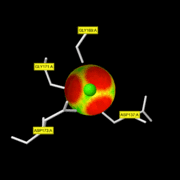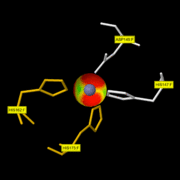Sandbox Reserved 1125
From Proteopedia
(Difference between revisions)
| Line 26: | Line 26: | ||
MMP8 is composed of several domains: a propeptide, a catalytic domain, a hinge region, and a C-terminal hemopexinlike domain. | MMP8 is composed of several domains: a propeptide, a catalytic domain, a hinge region, and a C-terminal hemopexinlike domain. | ||
Thanks to X-ray crystallography, the structure of 2OY4 has been solved with 1,7 Å resolution. This enzyme consists of <scene name='71/719866/Helixes/3'>three alpha helixes</scene> and <scene name='71/719866/Sheets/2'>five beta sheets</scene>. | Thanks to X-ray crystallography, the structure of 2OY4 has been solved with 1,7 Å resolution. This enzyme consists of <scene name='71/719866/Helixes/3'>three alpha helixes</scene> and <scene name='71/719866/Sheets/2'>five beta sheets</scene>. | ||
| + | <ref='Pdf'>[Pdf]</ref> | ||
| + | |||
| + | |||
| + | === Propeptide === | ||
| + | |||
| + | |||
| + | |||
| + | |||
| + | |||
=== Pocket interaction === | === Pocket interaction === | ||
| Line 44: | Line 53: | ||
| - | + | === Catalytic domain === | |
It seems to have 163 residues involved in the catalytic domain: Met80-Gly242. | It seems to have 163 residues involved in the catalytic domain: Met80-Gly242. | ||
(http://www.ncbi.nlm.nih.gov/pmc/articles/PMC394940/?page=1). The catalytic zinc ion is situated at the bottom of the active-site. The other zinc ion and the two calcium ions are packed against the top of the beta sheet and presumably function to stabilize the catalytic domain. The polypeptide folding and in particular the zinc environment of the collagenase catalytic domain bear a close ressemblance to the astacins and the snake venom metalloproteinases. | (http://www.ncbi.nlm.nih.gov/pmc/articles/PMC394940/?page=1). The catalytic zinc ion is situated at the bottom of the active-site. The other zinc ion and the two calcium ions are packed against the top of the beta sheet and presumably function to stabilize the catalytic domain. The polypeptide folding and in particular the zinc environment of the collagenase catalytic domain bear a close ressemblance to the astacins and the snake venom metalloproteinases. | ||
The catalytic domain alone has proteolytic activity against other protein substrates and synthetic substrates. | The catalytic domain alone has proteolytic activity against other protein substrates and synthetic substrates. | ||
| + | === Homopexin domain === | ||
| + | The hemopexin domain has two conserved cysteines that are disulfide bonded. Mutation of those cysteines to alanines (25) or reduction and alkylation destroys collagenolytic activity (K. Suzuki and H.Nagase, unpublished results).<ref='Pdf'/> | ||
| - | + | == Mechanism == | |
To express collagenolytic activity, they have to retain both the catalytic and hemopexin domains. | To express collagenolytic activity, they have to retain both the catalytic and hemopexin domains. | ||
It is not clear how the hemopexin domain help to cleave triple-helical collagens because the isolated hemopexin domains of MMP-8 does not bind to collagen.<ref>PMID:8489511</ref> | It is not clear how the hemopexin domain help to cleave triple-helical collagens because the isolated hemopexin domains of MMP-8 does not bind to collagen.<ref>PMID:8489511</ref> | ||
Revision as of 10:16, 28 January 2016
MMP8
MMP-8, also called, Neutrophil collagenase or Collagenase 2, is a zinc-dependent and calcium-dependent enzyme. It belongs to the matrix metalloproteinase (MMP) family which is involved in the breakdown of extracellular matrix in embryonic development, reproduction, and tissue remodeling, as well as in disease processes, such as arthritis and metastasis. The gene coding this family is localized on the chromosome 11 of Homo sapiens .[1]
| |||||||||||
References
- ↑ "MMP8 matrix metallopeptidase 8 (neutrophil collagenase)"
- ↑ Stams T, Spurlino JC, Smith DL, Wahl RC, Ho TF, Qoronfleh MW, Banks TM, Rubin B. Structure of human neutrophil collagenase reveals large S1' specificity pocket. Nat Struct Biol. 1994 Feb;1(2):119-23. PMID:7656015
- ↑ Knauper V, Osthues A, DeClerck YA, Langley KE, Blaser J, Tschesche H. Fragmentation of human polymorphonuclear-leucocyte collagenase. Biochem J. 1993 May 1;291 ( Pt 3):847-54. PMID:8489511
- ↑ "Neutrophil collagenase"
- ↑ "Metalloendopeptidase activity"
- ↑ "Extra Binding Region Induced by Non-Zinc Chelating Inhibitors into the S1′ Subsite of Matrix Metalloproteinase 8"
RESSOURCE : Image:2oy4 mm1.pdb ( la structure du monomère )


